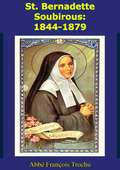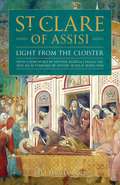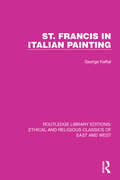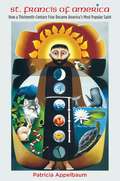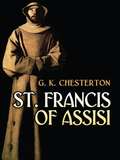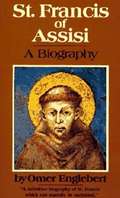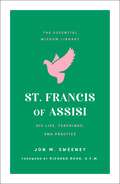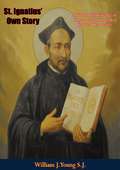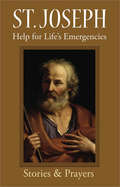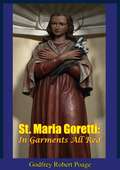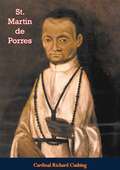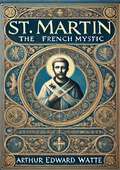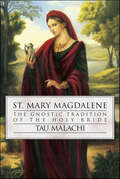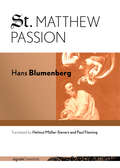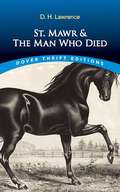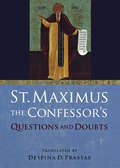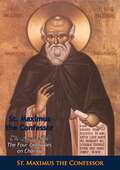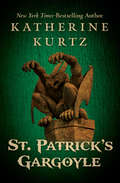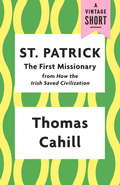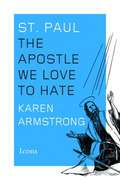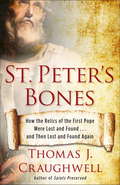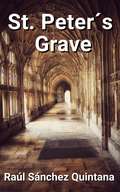- Table View
- List View
St. Bernadette Soubirous: 1844-1879
by John Joyce Abbé François TrochuST. BERNADETTE SOUBIROUS is a two-fold story: that of the apparition of the Blessed Virgin Mary at Lourdes, France in 1858, as well as of the 14-year-old peasant girl--raised in dire poverty and unable to read--to whom Our Lady appeared. But more, it is also the story of St. Bernadette's hidden life as a seemingly ordinary nun in her convent at Nevers, where she reached such holiness that after her death, God saw fit to preserve her body incorrupt--as it remains to this day!Beautifully set forth in this book are St. Bernadette's childhood and life at home, her character--honest, intelligent and straightforward--her description of Our Lady, the events surrounding the 18 apparitions, the opposition of the civil authorities, and the shrine and miraculous spring at Lourdes. Also described are Bernadette's life in the convent, where she suffered a martyrdom in body and in soul.
St. Clare of Assisi: Light From the Cloister
by Ofs Bret ThomanThis is a short but very readable biography of St. Clare of Assisi whose life intertwined with that of St. Francis. Her life was as a contemplative who had a deep love for poverty and prayer.
St. Francis in Italian Painting (Ethical and Religious Classics of East and West #2)
by George KaftalOriginally published in 1950, this book shows that the religious and ethical values that St. Francis was striving after are as essential today as they were in his time. The book presents St. Francis as a complex personality and corrects the rather mawkish interpretation of certain legends. It deals with the environment and development of the saint’s personality and chapters from his biographies by Thomas of Celano or St. Bonaventure and many black and white plates illustrating them which are reproductions of paintings by Italian masters from the XIIIth to the late XVth century.
St. Francis of America
by Patricia AppelbaumHow did a thirteenth-century Italian friar become one of the best-loved saints in America? Around the nation today, St. Francis of Assisi is embraced as the patron saint of animals, beneficently presiding over hundreds of Blessing of the Animals services on October 4, St. Francis's Catholic feast day. Not only Catholics, however, but Protestants and other Christians, Hindus, Buddhists, Jews, and nonreligious Americans commonly name him as one of their favorite spiritual figures. Drawing on a dazzling array of art, music, drama, film, hymns, and prayers, Patricia Appelbaum explains what happened to make St. Francis so familiar and meaningful to so many Americans. Appelbaum traces popular depictions and interpretations of St. Francis from the time when non-Catholic Americans "discovered" him in the nineteenth century to the present. From poet to activist, 1960s hippie to twenty-first-century messenger to Islam, St. Francis has been envisioned in ways that might have surprised the saint himself. Exploring how each vision of St. Francis has been shaped by its own era, Appelbaum reveals how St. Francis has played a sometimes countercultural but always aspirational role in American culture. St. Francis's American story also displays the zest with which Americans borrow, lend, and share elements of their religious lives in everyday practice.
St. Francis of Assisi
by G. K. ChestertonThe patron saint of animals, birds, and the environment, Francis of Assisi led the rediscovery of nature in the Christian West. This magnificent spiritual biography by the phenomenally popular G. K. Chesterton—a convert to Catholicism—chronicles the beloved saint's calling, his extraordinary life, and his influence in the Church. Its charm and wit will appeal to even the most secular-minded readers. How fitting that Francesco Bernardone was born just after the Dark Ages when the world was awakening. He started out as a colorful troubadour with a fondness for French poetry, extravagant with money . . . until the sight of a beggar seeking alms opened his eyes to a world beyond himself. The scene so moved him, he vowed to God that he would devote his life to the poor and embrace a life of simplicity. This sense of humility and generosity continues to call to each of us today. With great affection, Chesterton explores the life and times of St. Francis—his joyous devotion, his sense of compassion and love for all creation, his visions and miracles, his stigmata, and his band of followers that became the Franciscan Order. Praising this great and original man who became one of the most popular figures in Christendom, the author calls him "a poet whose whole life was a poem." Here is a stimulating read for Chesterton fans, Christian readers, and anyone looking for a burst of pure inspiration.
St. Francis of Assisi: A Biography
by Omer EnglebertSt. Francis of Assisi is one of the best-known and best-loved of all the saints. This classic work puts him in the context of his historical setting and his spiritual influences. Inspired by a deep and simple love, Francis abandoned his fortune and chose to live simply. His love for Jesus Christ, his love for animals, and his love for nature continue to inspire many to this day.
St. Francis of Assisi: His Life, Teachings, and Practice (The Essential Wisdom Library) (The Essential Wisdom Library)
by Jon M. SweeneyAn introduction to St. Francis's life and his most profound teachings of faithSt. Francis of Assisi is one of the most venerated Christian figures, and his profound teachings, deep love of nature, and commitment to simplicity have resonated with generations of followers. St. Francis of Assisi, the latest title in the Essential Wisdom Library, offers a simple and universal introduction to Francis’s life, his key teachings, and the spiritual practices that enriched his faith and the lives of those who follow his legacy. Author Jon M. Sweeney, one of the most popular Francis interpreters, introduces the iconic Christian as a man of his time and as one whose wisdom transcends eras. Beginning with a timeline of the saint’s life, St. Francis of Assisi includes the teachings that made Francis such a unique and powerful figure. His words apply to a diverse set of situations—from advice for people in positions of power, to teachings on gratitude, and the Rule of Life which governed every facet of life for Franciscans. The book concludes with explanations of some of his most powerful practices, which can offer wisdom and insight for our own lives. St. Francis emphasized the importance of living a simple, truthful life, making his spiritual practices just as impactful and relevant in the modern day as they were centuries ago. St. Francis of Assisi is the perfect guide for anyone looking to learn more about the saint or hoping to incorporate his wisdom into their own spiritual lives.
St. Gregory’s Prayer Book
by Ordinariate of the Chair of St PeterThe St. Gregory's Prayer Book is a beautifully produced leatherette prayer book compiled by the Ordinariates established by Pope Benedict XVI and drawing on the riches of the Anglican liturgical heritage and the exquisite Cranmerian language of the Book of Common Prayer to further enrich the panoply of Catholic liturgy and devotion. <p><p> The text includes ancient English collects, introits and hymns available together for the first time for the whole Church as approved examples of Catholic liturgy. In addition to the Liturgical texts, classic translations of traditional prayers and devotions for use in the Church and in the home have been lovingly compiled and edited in St. Gregory's Prayer Book.
St. Ignatius' Own Story: As Told to Luis Gonzalez de Camara with a Sampling of Ignatius' Own Letters
by William J. Young S.J. Saint Ignatius of LoyolaThis book, one in the series "Library of Living Catholic Thought," is published in special commemoration of the Ignatian Year - the four-hundredth anniversary of the death of St. Ignatius Loyola. This is an account of days remembered by the saint and dictated by him to his faithful disciple, González de Cámara. It covers the period from his wounding and surrender to the French at Pamplona in 1521 to the time of his coming to Rome in November 1537. St. Ignatius dictated his story only after long and continuous pressure on the part of his spiritual sons to give them some account of his founding of the Society of Jesus. Father de Cámara was fortunately gifted with an extraordinary memory. He took notes as Ignatius dictated, and later wrote out at greater length the discourse as he remembered hearing it from the lips of Ignatius, making use even of his very words. The dictation, as was to be expected, was brief and summary and to the point, with no attempt at literary polish. In the translation some attempt has been made to preserve the rather homespun texture of the language. Latin versions were early available, but this book represents the first translation into English from the original text.-Print ed.
St. Innocent: Apostle To America
by Paul D. GarrettThis eminently readable biography traces the course of North America's beloved Orthodox saint, Innocent of Alaska: his boyhood in Siberia, his call to mission in America, his labors first as a priest and then as a bishop in America and Asia, and his last years as Metropolitan of Moscow. Revealing the many facets of his warm personality and abiding interest in the natural and social sciences, this portrait fully describes him as a man of affection with an unfailing sense of humor. In this work, St Innocent emerges as an apt and accessible example of a dedicated bondservant of Jesus Christ.
St. John and the Victorians
by Michael WheelerThe Gospel according to St John, often regarded as the most important of the gospels in the account it gives of Jesus' life and divinity, received close attention from nineteenth-century biblical scholars and prompted a significant response in the arts. This original interdisciplinary study of the cultural afterlife of John in Victorian Britain places literature, the visual arts and music in their religious context. Discussion of the Evangelist, the Gospel and its famous prologue is followed by an examination of particular episodes that are unique to John. Michael Wheeler's research reveals the depth of biblical influence on British culture and on individuals such as Ruskin, Holman Hunt and Tennyson. He makes a significant contribution to the understanding of culture, religion and scholarship in the period.
St. Joseph
by Kathryn J. HermesSaint Joseph, foster father of Jesus and husband of Mary, is often called on to intercede in the selling of a house. However, those with a devotion to Saint Joseph know that he can help with much more: employment, family issues, happy death, finances, divine providence, home improvement, and good health. Let the stories and prayers in this book help you open your heart to the care that Saint Joseph can provide.
St. Maria Goretti: In Garments All Red
by Godfrey Robert Poage C.P.MARIA GORETTI was not yet 12 years old when she was faced with that momentous decision in July of 1902: Sin or death. Maria's answer to her assailant was clear: "No! No! It is a sin! God does not want this!" Alessandro stabbed Maria 14 times, and little Maria became another virgin martyr in the line of St. Agnes and St. Cecilia.Here is the beautiful true story of Maria's virtuous life that led to her heroic choice, of the Goretti family's terrible poverty, Maria's First Holy Communion, her great maturity in shouldering adult responsibilities, her forgiveness of her murderer, her lingering death, then finally her public elevation to sainthood in 1950--in the presence of her mother, her family and the largest crowd ever before seen at a canonization--over half a million people.A contemporary classic, this is truly a book for all--because people of any age will be inspired by St. Maria Goretti's purity and love of God--which triumphed over her love for life and even over the anonymity of death.
St. Martin de Porres
by Cardinal Richard CushingThe life and works of Martin de Porres Velázquez, a Peruvian lay brother of the Dominican Order born December 9, 1579 in Lima, Peru to Ana Velázquez, a freed slave from Panama, and Don Juan de Porres, a Spanish nobleman. De Porres worked in the ghettos of Lima, Peru among poor whites, blacks, Indians and mestizos. Illustrations include artwork by Rev. Norbert Georges, as well as photos of the canonization of de Porres on May 6, 1962. De Porres, who was beatified in 1837 by Pope Gregory XVI and canonized in 1962 by Pope John XXIII, is particularly notable as he was the first person of color to be sainted. De Porres is the patron saint of mixed-race people, barbers, innkeepers, public health workers, and all those seeking racial harmony.
St. Martin: The French Mystic
by Professor Arthur Edward WaiteSt. Martin: The French Mystic by Professor Arthur Edward Waite is a captivating exploration of the life, teachings, and spiritual legacy of Louis Claude de Saint-Martin, one of the most enigmatic and influential mystics of the 18th century. Waite, a renowned scholar of esotericism and mysticism, presents a thorough and insightful study of Saint-Martin’s mystical philosophy, which has left an indelible mark on Western esoteric traditions.In this comprehensive biography, Waite delves into Saint-Martin’s early life, his philosophical development, and his deep involvement with the esoteric currents of his time. He traces Saint-Martin’s journey from being a disciple of the enigmatic Martinist, Martinez de Pasqually, to becoming a revered mystic in his own right, known for his profound spiritual writings and his quest for inner enlightenment.St. Martin: The French Mystic explores the central themes of Saint-Martin’s teachings, including the nature of the soul, the process of spiritual regeneration, and the quest for divine wisdom. Waite examines Saint-Martin’s concept of “The Unknown Philosopher,” a symbolic representation of the inner spiritual guide that leads seekers toward higher truth and understanding. Through careful analysis, Waite reveals how Saint-Martin’s mysticism was deeply rooted in Christian spirituality while also embracing universal principles that resonate across different religious and philosophical traditions.Waite’s scholarly yet accessible writing brings Saint-Martin’s ideas to life, making this book an essential read for anyone interested in mysticism, esoteric Christianity, and the history of Western spiritual thought. He provides a balanced and nuanced portrayal of Saint-Martin, highlighting both his intellectual contributions and his personal spiritual experiences.St. Martin: The French Mystic is a profound study of a thinker whose influence extends far beyond his time. Arthur Edward Waite’s meticulous research and deep understanding of mystical traditions make this work a valuable resource for students of mysticism and spiritual seekers alike. This book offers readers an opportunity to engage with the rich spiritual legacy of one of France’s most revered mystics.
St. Mary Magdalene: The Gnostic Tradition of the Holy Bride
by Tau MalachiA gnostic biography that brings to light the importance and spirituality of the Christian saint Mary of Magdala.In the Gospels of the Bible there are a few comments about Mary Magdalene here and there. But in the Gnostic scriptures that have been discovered, there are tantalizing hints that both her relationship to Jesus and her role among Jesus' disciples may have been profoundly important. Among several schools of Gnostic Christianity, Mary plays an essential role in the revelation of the gospel.Here, for the first time in print, is a Sophian Gospel of St. Mary Magdalene. No secret oral tradition as extensive as this has ever been recorded, and none has ever presented a Gnostic view of Mary Magdalene as she is portrayed in this groundbreaking work—as a powerful holy woman, the innermost disciple and beloved wife of Jesus, and a Christed woman who is coequal with Jesus in the Christ revelation.
St. Matthew Passion (signale|TRANSFER: German Thought in Translation)
by Hans BlumenbergSt. Matthew Passion is Hans Blumenberg's sustained and devastating meditation on Jesus's anguished cry on the cross, "My God, my God, why have you forsaken me?" Why did this abandonment happen, what does it mean within the logic of the Gospels, how have believers and nonbelievers understood it, and how does it live on in art? With rare philological acuity and vast historical learning, Blumenberg unfolds context upon context in which this cry has reverberated, from early Christian apologetics and heretics to twentieth-century literature and philosophy. Blumenberg's guide through this unending story of divine abandonment is Johann Sebastian Bach's monumental Matthäuspassion, the parabolic mirror that bundled eighteen hundred years of reflection on the fate of the crucified and the only available medium that allows us post-Christian listeners to feel the anguish of those who witnessed the events of the Passion. With interspersed references to writers such as Goethe, Rilke, Kafka, Freud, and Benjamin, Blumenberg gathers evidence to raise the singular question that, in his view, Christian theology has not been able to answer: How can an omnipotent God be so offended by his creatures that he must sacrifice and abandon his own Son?
St. Mawr & The Man Who Died (Dover Thrift Editions: Classic Novels)
by D. H. LawrenceD. H. Lawrence is celebrated for his bold artistic vision and transformative portrayal of sex and emotions. His evocative prose, penetrating psychological insights, and fearless examination of human nature offer a rich literary experience in two brilliant novellas. St. Mawr unveils a story of self-discovery and the stark contrast between modern civilization and nature’s raw, untamed spirit. Fleeing from a complacent marriage, Lou Witt finds solace in a remote ranch in the mountains of New Mexico alongside a fiery stallion. The Man Who Died explores Resurrection and enlightenment from a mystical and metaphysical perspective. This profound parable reimagines the story of Jesus Christ post-Resurrection, engaging with themes of rebirth, sexual awakening, and divine humanism. Lawrence’s narrative challenges traditional religious dogma, proposing a more personal and sensual understanding of spirituality. Together, these works offer a transformative exploration of the human spirit’s quest for meaning and authenticity, making them a significant contribution to twentieth-century literature.
St. Maximus the Confessor's "Questions and Doubts"
by Saint Maximus the ConfessorDespina D. Prassas's translation of the Quaestiones et Dubia presents for the first time in English one of the Confessor's most significant contributions to early Christian biblical interpretation. Maximus the Confessor (580–662) was a monk whose writings focused on ascetical interpretations of biblical and patristic works. For his refusal to accept the Monothelite position supported by Emperor Constans II, he was tried as a heretic, his right hand was cut off, and his tongue was cut out. In his work, Maximus the Confessor brings together the patristic exegetical aporiai tradition and the spiritual-pedagogical tradition of monastic questions and responses. The overarching theme is the importance of the ascetical life. For Maximus, askesis is a lifelong endeavor that consists of the struggle and discipline to maintain control over the passions. One engages in the ascetical life by taking part in both theoria (contemplation) and praxis (action). To convey this teaching, Maximus uses a number of pedagogical tools including allegory, etymology, number symbolism, and military terminology. Prassas provides a rich historical and contextual background in her introduction to help ground and familiarize the reader with this work.
St. Maximus the Confessor: The Ascetic Life. The Four Centuries on Charity
by St. Maximus the ConfessorSt. Maximus the Confessor might well be called the Saint of Synthesis. His thought places him between the theologies of East and West and between the Middle Ages and the ancient Church. The Ascetic Life takes the form of question and answer between a novice and an old monk. The Four Centuries on Charity is written in the form of gnomic literature.-print ed.
St. Patrick's Gargoyle
by Katherine KurtzA gargoyle guardian and a Knight of Malta unite to seek justice when Dublin's St. Patrick's Cathedral is vandalized in this delightful modern-day fantasy. The gargoyles of Dublin, Ireland, have a sacred duty to perform. Formerly God's avenging angels, for centuries they have been entrusted with guarding the churches and cathedrals of the Irish capital while avoiding all contact with human beings. But once a month these loyal stone sentries must leave their posts to attend a conclave of their kind, and it is during one such absence that a sacrilege occurs. The guardian of St. Patrick's Cathedral, the gargoyle Padraig, called "Paddy," has returned to find violence and vandalism committed at his church and two silver artifacts stolen. Taking to Dublin's night streets in search of a culprit, Paddy inadvertently reveals himself to an aged chauffeur in an ancient Rolls Royce, thereby dooming Francis Templeton to an impending premature death. But the grim reaper will have to wait, because old man Templeton is a member of the Knights of Malta, a secret order of defenders of the faith dating back to the Crusades, and as such is an ideal partner for the onetime angel in his quest for justice and revenge. Their hunt is about to take some sinister turns, however, leading the gargoyle and the knight to Clontarf Castle, where a major demon, an emissary of Satan, is preparing to make his reentrance into the world. An acclaimed and much beloved fantasist best known for her popular Adept and Knights Templar series and her chronicles of the magical Deryni, Katherine Kurtz now displays another side of her extraordinary talent and succeeds magnificently. St. Patrick's Gargoyle is a delightful feast of the imagination, rich in Celtic lore and religious arcana, and brimming with wit and heart, wonder and magic.
St. Patrick: The First Missionary
by Thomas CahillA selection from How The Irish Saved Civilization, everything you need to know about the historical St. Patrick, the extraordinary Iron Age man who became Ireland's patron saint. The real St. Patrick neither dressed in green nor chased the snakes from Ireland; instead, he was a kind and courageous former slave who had been stolen from Britain during childhood and brought to Ireland. Though he escaped from slavery, he later returned in triumph to the island of his captivity. From the first volume of his widely acclaimed "Hinges of History" series, Thomas Cahill brings St. Patrick to life, and sheds light on the chaotic but starkly beautiful ancient Ireland. An eBook short.
St. Paul: The Apostle We Love to Hate
by Karen ArmstrongSt. Paul is known throughout the world as the first Christian writer, authoring fourteen of the twenty-seven books in the New Testament. But as Karen Armstrong demonstrates, he also exerted a more significant influence on the spread of Christianity throughout the world than any other figure in history. It was Paul who established the first Christian churches in Europe and Asia in the first century, Paul who transformed a minor sect into the largest religion produced by Western civilization, and Paul who advanced the revolutionary idea that Christ could serve as a model for the possibility of transcendence. While we know little about some aspects of the life of St. Paul--his upbringing, the details of his death--his dramatic vision of God on the road to Damascus is one of the most powerful stories in the history of Christianity, and the life that followed forever changed the course of history. Some books, long-held to be written by Paul, were not written by him and some of his books were later edited to contain material not by him.
St. Peter's Bones: How the Relics of the First Pope Were Lost and Found . . . and Then Lost and Found Again
by Thomas J. CraughwellIn this fascinating account of the search for the remains of the world's first pope, none other than Peter, the chief apostle of Jesus, Thomas J. Craughwell takes us on one of the most exciting archaeological finds of the twentieth century. In 1448 a team of architects and engineers brought Pope Nicholas V unhappy news: the 1,100-year-old Basilica of St. Peter suffered from so many structural defects that it was beyond repair. The only solution was to pull down the old church--one of the most venerable churches in all of Christiandom--and erect a new basilica on the site. Incredibly, one of the tombs the builders paved over was the resting place of St. Peter. Then in 1939, while reconstructing the grottoes below St. Peter's Basilica, a workman's shovel struck not dirt or rock but open air. After inspecting what could be seen through the hole they'd made in the mausoleum's roof, Pope Pius XII secretly authorized a full-scale excavation. What lay beneath? The answer and the adventure await. In this riveting history, facts, traditions, and faith collide to reveal the investigation, betrayals, and mystery behind St. Peter's burial place.
St. Peter's Grave
by Raul Sanchez QuintanaIn 1953, during the times of exile destinated to construct the church of Dominus Flevit in the Olive Mount the Franciscans in Holy Land found an old cementary. Between the remains, they found a sarcophagus that was very important for the Christians, it grabbed their attention (real facts). The founding and content was communicated to Pio XII who quickly ordered to destruct part of the remains, however three frairs decided not to obey him and keep the discovery. Sixty years have passed and the three frairs die in different circumstances, the secret that jealousy they had kept. Since this instant, several interested people would try no know what was in that discovery found in the Olives Mount, with the objective of controling a weak Vatican, that had compromised relashionships from the high Curia and the Cosa Nostra. The novel that tried to reveal the motives that took Ratzinger to make the decision of abandoning the post of Saint Peter, this book develops in the times of Benedict XVI and the election of Pope Francis. But the novel starts to develop in the city of Granada, little by little it moves to the Vatican and the Island of Sicily.
